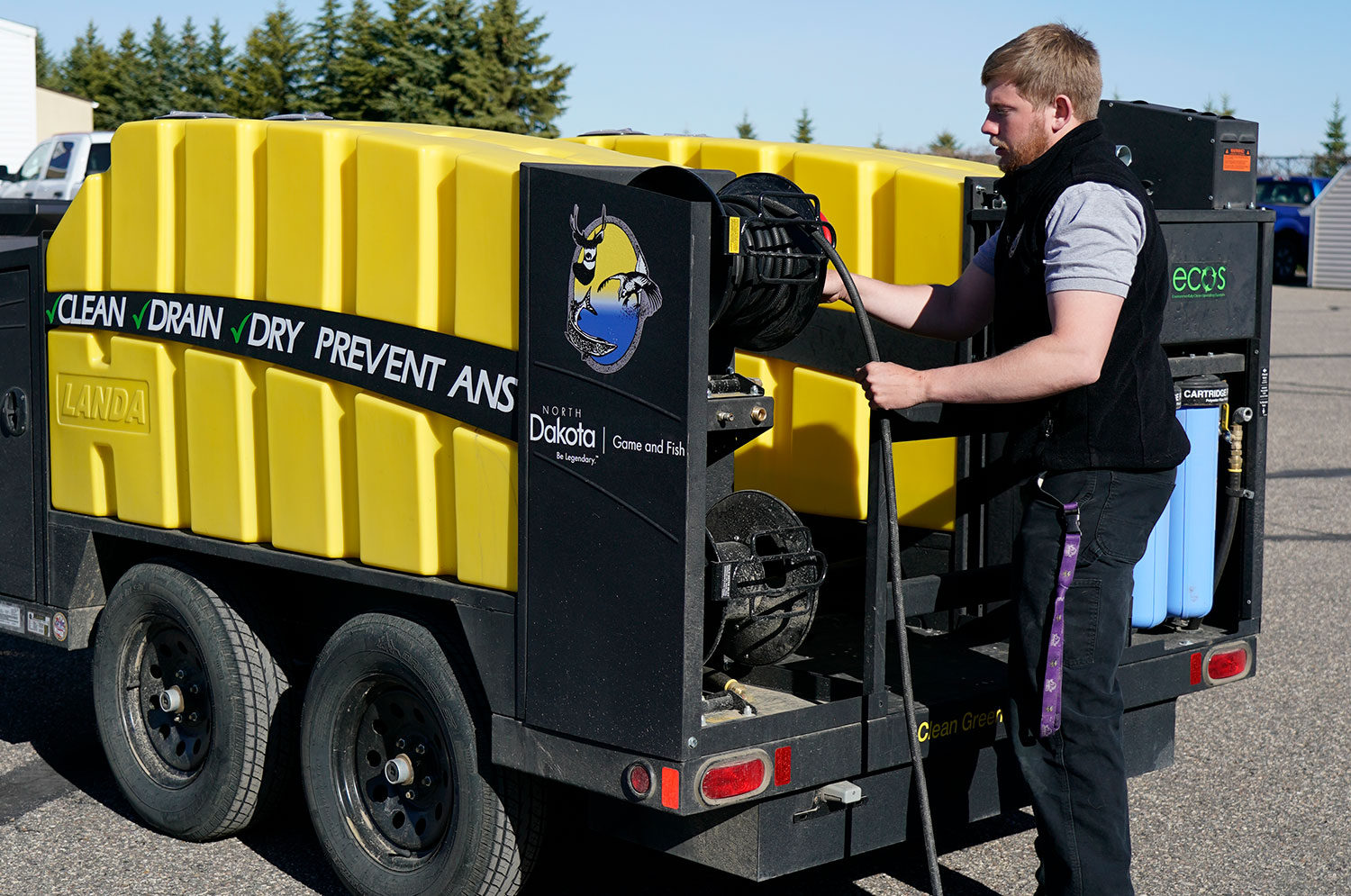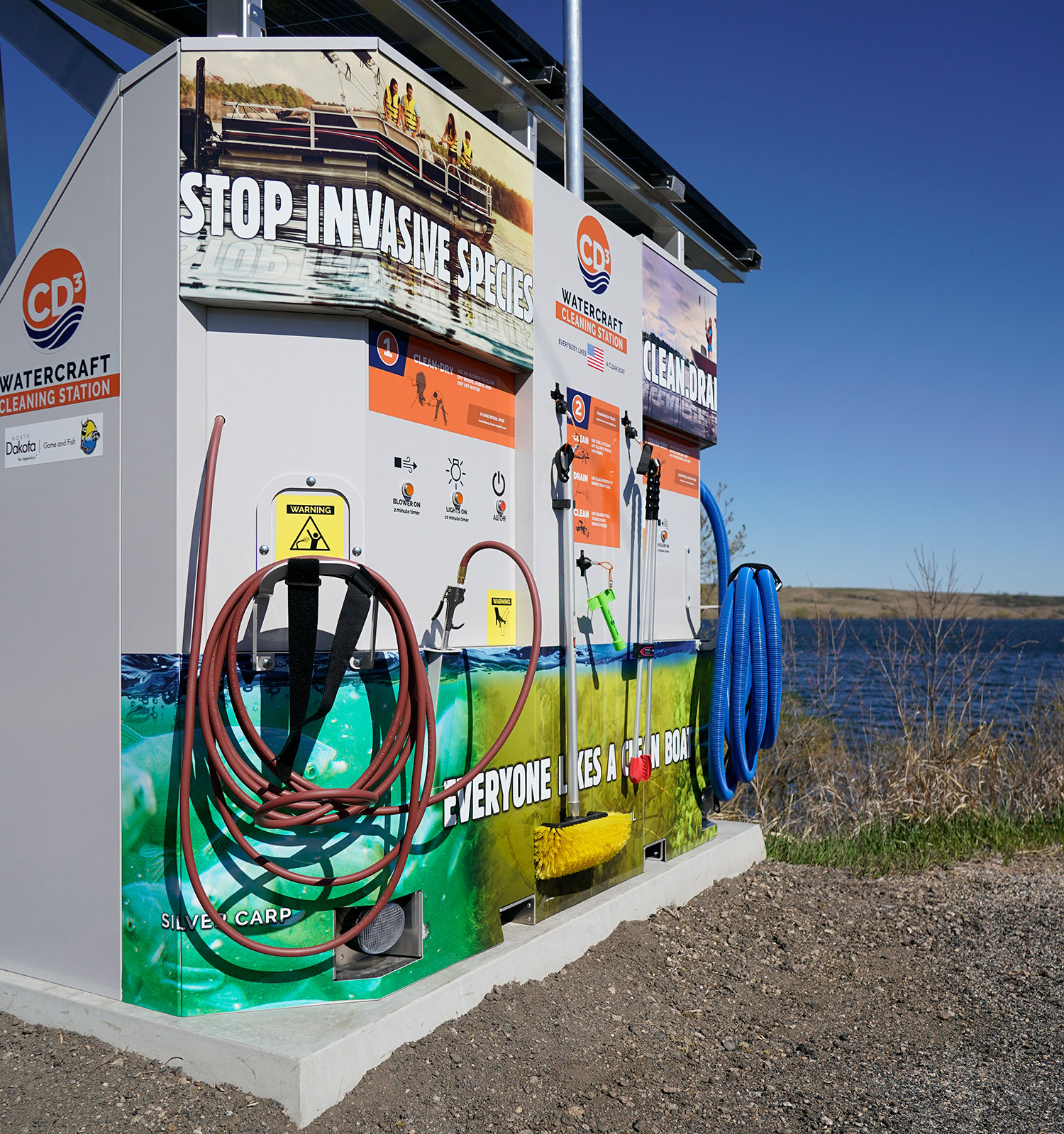The North Dakota Game and Fish Department’s effort to stop the introduction and spread of aquatic nuisance species in waters across the state is ongoing and getting stronger.
Ben Holen, Department ANS coordinator, said that while Lake LaMoure was added in 2020 to a short list of waters with zebra mussels in the state, North Dakota is fortunate to have low numbers of aquatic nuisance species.
“And we want to keep it that way,” Holen said. “We have great water resources here in North Dakota, but we stand to lose some of that if aquatic nuisance species spread into our lakes and rivers.”
And more than just fishing and hunting opportunities are lost if aquatic nuisance species go unchecked.
“We have good water infrastructure and aquatic nuisance species can cut off water supply to farm fields, municipalities and hydroelectrical facilities,” he said.
Other than zebra mussels, North Dakota has just a few aquatic invasive plants and animals including curly leaf pondweed, Eurasian watermilfoil, bighead, silver and common carp. Curly leaf pondweed can be found throughout the Missouri River System, Lake Metigoshe, the Sheyenne River in Barnes County, and a few small reservoirs.
In the last five or six years, Eurasian watermilfoil has only been documented in the Sheyenne River in Barnes County. Bighead and silver carp are only found in the James River, while common carp are widespread and are found in many waters across the state.
New in 2021 in the continued campaign against ANS is a Game and Fish Department digital marketing campaign, targeting many of the state’s bigger waterbodies and high risk ANS infested waters.
“At those ANS infested waters, anglers and recreational boaters will be seeing an increase in watercraft inspectors,” Holen said. “We’re greatly increasing our watercraft inspection force and getting more people on the landscape to catch aquatic nuisance species.”
Holen and Grant Kapaun, Department ANS biologist, supervise 11 full-time watercraft inspectors. Additionally, another six seasonal employees will be conducting watercraft inspections this summer.
Boaters should expect to see inspectors at: Devils Lake, Stump Lake, Lake LaMoure, Lake Ashtabula, Lake Oahe, Lake Sakakawea, Lake Audubon, Lake Metigoshe, Red River, Alkaline Lake, Lake Tschida and possibly other waters depending on boater traffic.
Holen said the boat inspections take less than 5 minutes.
“The inspectors will ask a series of questions to assess the risk of your watercraft and from there, inspect your watercraft and remove any high-risk scenarios so that your biological risk of your watercraft is low when exiting or entering a water body,” he said.

Ben Holen, Depar tment ANS coordinator, with a mobile ANS decontamination unit .
The boat inspections are, in part, another way to educate water users on the threat of aquatic nuisance species.
“That’s one of our main priorities,” Holen said. “Boaters should feel free to ask the inspectors any questions … it’s just an overall good way to learn more about aquatic nuisance species.”
Also new this year at Grahams Island State Park on Devils Lake, Lake Ashtabula and Lake LaMoure are virtual inspection/voice audio playing devices, or ILIDS, at boat ramps to help stop the spread of ANS.
Holen said once a vehicle/boat is in range of the inspection devices, a magnetic sensor is tripped.
“When the sensor is tripped, the ILID will look for motion and if motion is detected, then record video,” Holen sad. “The video is sent to a website where I, or wardens, can review it. Also, when the magnetic sensor is tripped, an audio recording will play a short message to remind boaters to drain all livewells and ballast tanks.”
Boaters are also remind about the Department-installed boat cleaning station near the Red River in Grand Forks and at Lake Ashtabula and Lake Metigoshe.
The self-serve, waterless CD3 units are free and open to the public and include a high-powered air hose, broom, wet/dry vac, a tool for removing vegetation from underneath boat trailers and flood lights to illuminate the cleaning process in low light.
“Wash stations are also available at Lake Tschida for public use. The Lake Lamoure wash station is nearly complete and there are plans to have a set of wash stations available at Jamestown Reservoir,” Holen said. “The Game and Fish Department also has a mobile decontamination unit that is used for high-risk commercial equipment and mussel-fouled boat decontaminations.”
Earlier this spring, Holen deconned the first mussel-fouled boat of the season coming off Lake Ashtabula.
“We also have clean, drain, dry stamps and stencils on ramps that remind people to clean, drain, dry whenever they come off the water,” Holden said. “All of these things are in place to lower the risk of aquatic nuisance species in our lakes and rivers and to keep our lakes and rivers good for a long time.”
Part of this strengthened effort against ANS also includes the Department’s continued sampling of many waters around the state.
“We sample over 140 waterbodies ever year for zebra and quagga mussels,” Holen said. “And we do vegetation sampling … we’re looking for many other aquatic nuisance species.”
Preventing the Spread of Aquatic Nuisance Species

ANS Boat Cleaning Station
North Dakota anglers, water recreationists and anyone working in lakes or streams are reminded to follow these simple regulations to help prevent the spread of aquatic nuisance species.
Know the laws, as each state and province have their own rules and regulations. North Dakota regulations include:
- Do not import live aquatic bait.
- Use only legal bait species.
- Transport live bait in containers of five gallons or less.
- Properly dispose of unused bait.
- Drain water and remove vegetation from all equipment when leaving a waterbody.
- Remove drain plugs and keep out or open during transport.
- Anglers may not transport live bait in water away from any Class I ANS infested water (currently the Red River, Lake Ashtabula, and the Sheyenne River from Lake Ashtabula downstream to the Red River).
- Clean, drain and dry any equipment (recreational or commercial) that is used in any waterbody.
- Clean: remove plants, animals and excessive mud from trailers, hulls, motors and other equipment such as fishing gear and watersports equipment.
- Drain: drain all water, including bilges, livewells and bait buckets.
- Dry: allow all equipment to dry completely or decontaminate before using again. If necessary, use sponges or towels to remove excess water and allow compartments to dry.
- Report any plant or animal that seems out of place.
- Visit the online reporting form at the Game and Fish website, gf.nd.gov.
Also, North Dakota boaters who are traveling to or through other states or Canadian provinces, are reminded to check the aquatic nuisance species regulations of their destination, to make sure they are in compliance.
Mandatory boat inspections may be required along highways or at lakes based on destination or route taken. In general, to ensure compliance, boaters are encouraged to clean, drain and dry equipment.




